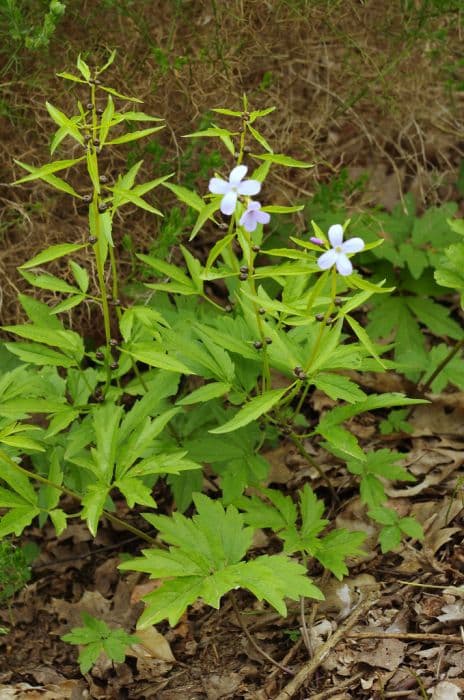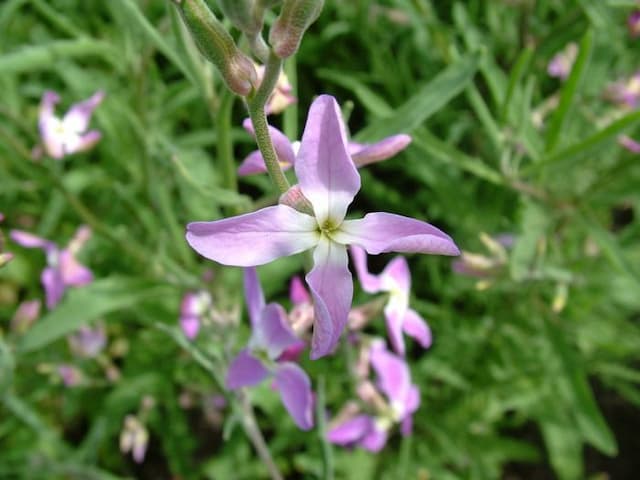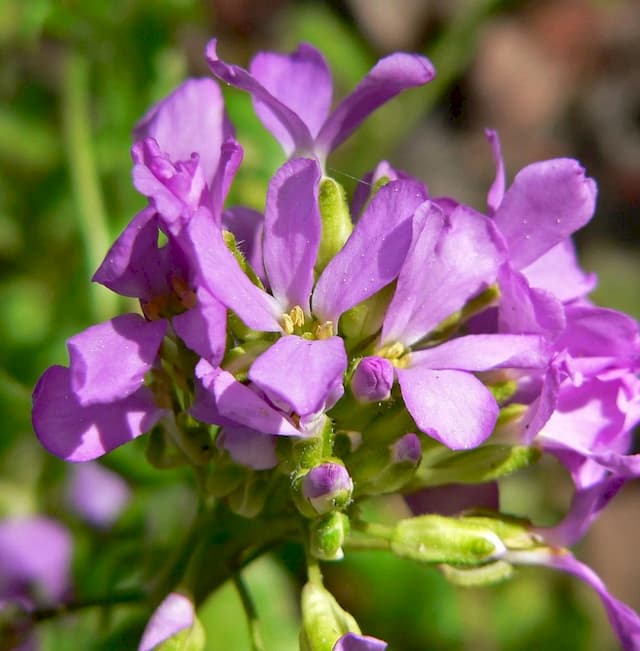Cauliflower 'Romanesco' Brassica oleracea (Botrytis Group) 'Romanesco'
ABOUT
A vegetable plant with green leaves and an edible head of pointed, lime-green florets densely arranged in whorls produced in summer and autumn
About this plant
 Names
NamesFamily
Brassicaceae.
Synonyms
Romanesco Broccoli, Roman Cauliflower, Romanesco Cauliflower, Romanesque Cauliflower.
Common names
Brassica oleracea var. botrytis 'Romanesco'.
 Characteristics
CharacteristicsLife cycle
Biennials
Foliage type
Deciduous
Color of leaves
Green
Flower color
Yellow
Height
2 feet 6 inches (76 centimeters)
Spread
2 feet (61 centimeters)
Plant type
Herb
Hardiness zones
3
Native area
Mediterranean
Benefits
 General Benefits
General Benefits- Nutrient-Rich: Romanesco is a good source of vitamins C and K, fiber, and carotenoids, supporting overall health.
- Culinary Versatility: It can be eaten raw, steamed, roasted, or pureed, making it a versatile ingredient in the kitchen.
- Low-Calorie: It is low in calories, making it ideal for weight-conscious diets.
- Aesthetic Appeal: Its fractal-like spirals make it an attractive addition to dishes, enhancing plate presentation.
- Garden Ornamentation: Romanesco is aesthetically unique and can create visual interest in a vegetable garden or edible landscape.
- Companion Planting: When grown alongside other crops, it can help reduce pest damage and increase pollination.
- Soil Improvement: As a member of the Brassicaceae family, it can help improve soil health when used in crop rotation.
 Medical Properties
Medical Properties- High in antioxidants - Romanesco broccoli contains various antioxidants that may reduce oxidative stress and lower the risk of chronic diseases.
- Source of vitamin C - This vegetable is rich in vitamin C, which may help strengthen the immune system and assist in collagen production.
- Dietary fiber content - The fiber in Romanesco broccoli can aid digestion and promote bowel regularity, potentially reducing the risk of colorectal diseases.
- Vitamin K - Romanesco contains vitamin K, which is essential for bone health and blood clotting.
- Folate - It provides folate, an important B-vitamin required for cell growth and metabolism, which is particularly important during pregnancy for fetal development.
- Glucosinolates - Romanesco broccoli is rich in glucosinolates, compounds that may have cancer-protective properties.
- Anti-inflammatory effects - Compounds in Romanesco may help reduce inflammation in the body, which is beneficial for preventing and managing inflammatory diseases.
 Air-purifying Qualities
Air-purifying QualitiesThis plant is not specifically known for air purifying qualities.
 Other Uses
Other Uses- Romanesco's fractal patterns can be used to inspire architectural designs, making use of its natural geometric structure to create visually intriguing and structurally sound forms.
- The plant's unique shape makes it an excellent educational tool for teaching mathematics, particularly in explaining fractals and Fibonacci sequences in a visual and tangible manner.
- Romanesco can be utilized in artwork, such as sculptures or printing patterns, where its intricate spirals can create interesting and natural repetitive designs.
- This vegetable can be used as a natural dye for fabrics, giving a soft green hue to textiles when boiled and used in the dyeing process.
- Romanesco can be carved into stamps for craft projects, where its natural pattern will leave a distinctive stamp on clay or paper.
- As a natural, biodegradable material, Romanesco stems and leaves could be used in the creation of compostable packaging materials or containers.
- When dried, the sturdy stems of Romanesco plants may serve as fuel for biomass boilers or as a component in the production of bio-char.
- The dense heads of Romanesco could potentially be used as a natural scrubbing tool for cleaning hard-to-reach places due to their textural surface.
- As an eco-friendly alternative, Romanesco leaves could be utilized as a natural mulch for gardening, helping to retain soil moisture and suppress weeds.
- The plant can serve as a biological educational specimen in schools to demonstrate plant growth stages, from seedling to mature vegetable, as it has distinct and observable developmental stages.
Interesting Facts
 Feng Shui
Feng ShuiRomanesco broccoli is not used in Feng Shui practice.
 Zodiac Sign Compitability
Zodiac Sign CompitabilityRomanesco broccoli is not used in astrology practice.
 Plant Symbolism
Plant Symbolism- Complexity and Precision: Romanesco's intricate spiral patterns exemplify nature's precision and complexity, making it symbolic of these concepts.
- Mathematical Beauty: Since Romanesco displays a natural approximation of a fractal, it often symbolizes the beauty of mathematics in nature.
- Innovation and Novelty: Romanesco's unique appearance makes it a symbol of innovation and the novelty of nature's creations.
- Natural Wonder: With its striking look, Romanesco is emblematic of the wonders that can be found in the natural world.
- Connection to Science: Romanesco is often used to symbolize the connection between science and nature due to its fractal geometry which is a subject of study in mathematics.
 Water
WaterRomanesco broccoli should be watered deeply and consistently to maintain even soil moisture; this usually equates to 1 to 1.5 inches of water per week, accounting for rainfall. It's best to water in the morning, which reduces evaporation and helps prevent foliar diseases by giving the leaves time to dry out during the day. During hot, dry periods, additional watering may be needed to prevent the soil from drying out. Overwatering can be just as harmful as underwatering, so ensure the soil is moist but not waterlogged. Use a soaker hose or drip irrigation to deliver water directly to the roots and minimize wetting the foliage.
 Light
LightRomanesco broccoli thrives in full sunlight conditions, requiring at least 6 to 8 hours of direct sunlight daily. An ideal spot would provide uninterrupted sun exposure throughout the day, as consistent light contributes to strong growth and optimal development of its distinctive fractal-shaped heads.
 Temperature
TemperatureThe Romanesco broccoli grows best in cooler temperatures between 60°F and 70°F. It can tolerate a minimum temperature of around 50°F, and growth is often suboptimal if temperatures exceed 75°F. This cool-season crop can handle light frosts, but temperatures below freezing can damage the plant.
 Pruning
PruningPruning is not commonly required for Romanesco broccoli, but removing any yellowing or damaged leaves can improve air circulation and overall plant health. The best time to prune is during the cool part of the day; early morning or late afternoon. Prune sparingly, only to maintain the plant's shape and health, and to remove occasional yellow leaves or any that show signs of disease or pest infestation.
 Cleaning
CleaningNot needed
 Soil
SoilRomanesco broccoli requires well-draining soil rich in organic matter with a pH between 6.0 and 7.0. A mix of garden soil, compost, and perlite or vermiculite is ideal to retain moisture and provide necessary nutrients.
 Repotting
RepottingRomanesco broccoli does not typically require repotting as it is grown as an annual plant. It should be planted in the garden or into a large container with fresh, nutrient-rich soil at the beginning of its growing season.
 Humidity & Misting
Humidity & MistingRomanesco broccoli thrives in outdoor conditions with average humidity levels. It does not have specific humidity requirements but prefers a consistent moisture level in the soil rather than the surrounding air.
 Suitable locations
Suitable locationsIndoor
Ensure full light, consistent watering, and cool temps for Romanesco.
Outdoor
Plant in full sun, in rich soil; keep watered and cool.
Hardiness zone
3-10 USDA
 Life cycle
Life cycleThe Romanesco cauliflower begins its life as a seed, which when sown and given the proper conditions, germinates and produces small seedlings with characteristic heart-shaped cotyledons. As it grows, the seedling develops true leaves and a sturdy stem, entering the vegetative stage where its foliage expands and becomes more robust in preparation for photosynthesis and growth. As it enters the reproductive phase, a central head or "curd" forms, characterized by its unique fractal pattern and spiraled florets, which is the Romanesco's defining feature. If allowed to mature further, this head will eventually produce yellow flowers which are pollinated by insects, leading to the formation of seed pods if successful fertilization occurs. The seeds within these pods can be harvested and used to repeat the growth cycle, completing the life cycle of the Romanesco. If the plant is not harvested for consumption during its prime edible stage, it will eventually decline as annuals do, completing its life span within a single growing season.
 Propogation
PropogationPropogation time
Spring to Summer
Romanesco broccoli, known botanically as Brassica oleracea (Botrytis Group) 'Romanesco', is typically propagated by seed. Seed propagation is the most popular method for growing Romanesco broccoli. Gardeners generally start the seeds indoors about six to eight weeks before the last expected frost date to get a head start on the growing season. Seeds should be sown about 1/4 to 1/2 inch (approximately 6 to 13 mm) deep in soil trays or small pots filled with a seed-starting mix. The pots should be kept in a warm, well-lit area and kept moist until germination, which usually occurs within five to ten days. Once seedlings emerge, they need plenty of light to avoid becoming leggy. When seedlings have grown a few sets of true leaves and the danger of frost has passed, they can be hardened off and transplanted into the garden, spaced about 18 to 24 inches (approximately 46 to 61 cm) apart to allow for their full growth.






![Aubrieta [Axcent Lilac]](/_next/image?url=https%3A%2F%2Fplants-admin.emdemapps.com%2Fimages%2Fplants%2F%2Fimages%2F604b5e2430fac.png&w=640&q=75)


